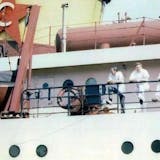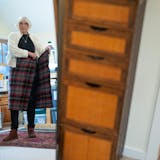I was walking beside a quiet two-lane highway in north central Kansas, admiring sculptures scattered in the scrubland, made from rusty farm implements, car parts and animal bones, when a small truck pulled up from a dirt driveway. It was the sculptor, waving.
"Thanks for being interested," he said. "I've got to go to work now." Off he drove, onto the empty blacktop and into open ranch land.
It was a fitting start to my latest exploration in and around the town of Lucas, pop. about 400, the state's capital of "grass-roots art." Also known as "outsider art," this is the creative outpouring of self-taught artists located far from the mainstream art world (geographically, commercially, aesthetically), using unconventional materials and techniques.
They are often retired farmers, mechanics, newspaper editors, funeral home directors (you name it) making stuff with whatever's around — car bumpers, light bulbs, barbed wire, gum, horseshoes, tree trunks (you name it). Prolific (some might say compulsive), they might not call themselves artists or even seek viewers for their work, which is typically found on their property.
In Lucas, it all started with Samuel Perry "S.P." Dinsmoor, an eccentric Civil War veteran, farmer and teacher who in the early 1900s, at age 64, began building a fantastical sculpture garden in the backyard of his cabin home, located on an otherwise ordinary small-town residential block — which is part of its charm and shock value. The sculpture garden took 22 years, 113 tons of cement and many tons of native rust-stained golden limestone.
Now known as the Garden of Eden, and listed on the National Register of Historic Places, it includes the unique cabin — also made by Dinsmoor, out of limestone "logs" — and the garden, with sculptures representing biblical figures (most notably Adam and Eve) and populist themes (most memorably, labor being crucified by the lawyer, doctor, preacher and banker).
A macabre highlight is the 40-foot ziggurat-shaped mausoleum that Dinsmoor built, also with limestone. Inside, as Dinsmoor wished, visitors on a tour can see what remains of his face — he died in 1932 at age 89 — through a glass-lidded coffin. Nearby, unseen, is his first wife. At age 81, Dinsmoor married his second wife — his 20-year-old housekeeper. They had two children.
Since Dinsmoor's day, locals and transplants — including grass-roots artists and aficionados — have helped cement Lucas' claim to fame. It now attracts more than 10,000 visitors a year. I've visited several times since the late 1980s and each time, I've found more to see in an area that still feels refreshingly off-the-beaten-path, making it a perfect outsider art outpost.


